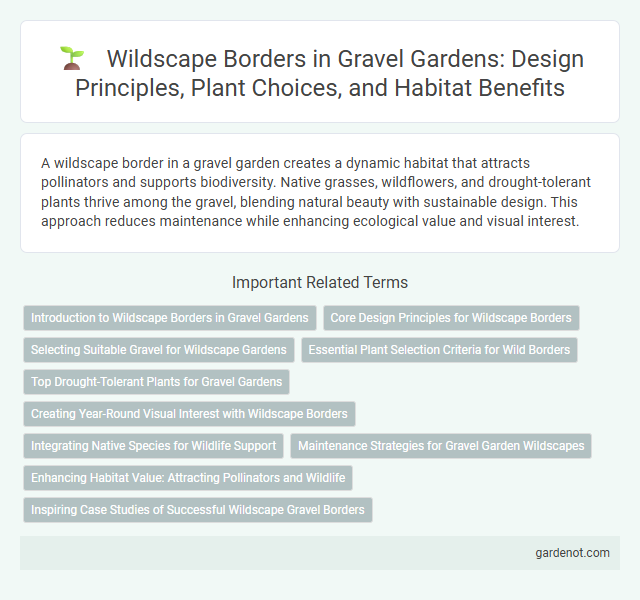A wildscape border in a gravel garden creates a dynamic habitat that attracts pollinators and supports biodiversity. Native grasses, wildflowers, and drought-tolerant plants thrive among the gravel, blending natural beauty with sustainable design. This approach reduces maintenance while enhancing ecological value and visual interest.
Introduction to Wildscape Borders in Gravel Gardens
Wildscape borders in gravel gardens create a dynamic habitat for native wildlife by combining drought-tolerant plants with naturalistic design elements. These borders support pollinators like bees and butterflies while enhancing biodiversity through the inclusion of grasses, wildflowers, and native shrubs adapted to well-drained gravelly soil. Implementing wildscape borders promotes sustainable gardening practices by reducing water usage and chemical inputs, making them ideal for eco-friendly garden environments.
Core Design Principles for Wildscape Borders
Wildscape borders prioritize biodiversity by incorporating native plant species that attract pollinators such as bees and butterflies, promoting ecological balance within a gravel garden. Core design principles emphasize layering plants according to height and bloom time to ensure year-round visual interest and sustenance for wildlife. Integrating structural elements like logs and native stones enhances habitat diversity while harmonizing with the gravel substrate for optimal drainage and soil health.
Selecting Suitable Gravel for Wildscape Gardens
Selecting suitable gravel for wildscape gardens involves choosing materials that support native plant growth and promote local biodiversity. Opt for natural, uncoated gravels with varied textures and colors to mimic natural habitats and enhance water permeability. Proper gravel selection helps maintain soil health, reduces erosion, and provides shelter for beneficial insects and wildlife in wildscape borders.
Essential Plant Selection Criteria for Wild Borders
Selecting plants for a wildscape border in a gravel garden requires prioritizing drought-tolerant species with deep root systems that thrive in well-drained, nutrient-poor soils typical of gravel substrates. Native perennials such as Eryngium (Sea Holly), Sedum (Stonecrop), and Salvia (Sage) enhance biodiversity while supporting pollinators and requiring minimal irrigation. The ideal plants should also offer seasonal interest with varied textures and colors to maintain aesthetic appeal throughout the year.
Top Drought-Tolerant Plants for Gravel Gardens
Wildscape borders thrive with top drought-tolerant plants such as lavender (Lavandula angustifolia), sedum (Sedum spectabile), and ornamental grasses like Festuca glauca, which excel in well-drained gravel conditions. Sempervivum, known for its rosette succulents, and Achillea millefolium offer vibrant, low-water foliage that attracts pollinators and requires minimal maintenance. Integrating these hardy species creates resilient borders that enhance biodiversity and maintain aesthetic appeal in drought-prone landscapes.
Creating Year-Round Visual Interest with Wildscape Borders
Wildscape borders in gravel gardens provide year-round visual interest by incorporating native plants that attract pollinators and support local wildlife. Combining evergreen shrubs, seasonal flowers, and textured grasses ensures color and structure throughout all seasons. Strategic planting enhances biodiversity while maintaining a low-maintenance, sustainable gravel garden design.
Integrating Native Species for Wildlife Support
A Wildscape border in a gravel garden integrates native species such as Echinacea purpurea, Asclepias tuberosa, and Rudbeckia hirta to provide essential habitats and food sources for local pollinators like bees, butterflies, and hummingbirds. Incorporating native grasses like Schizachyrium scoparium enhances soil stability and offers shelter for ground-nesting birds and beneficial insects. This biodiversity boost promotes a resilient ecosystem, supporting wildlife while requiring minimal maintenance and water.
Maintenance Strategies for Gravel Garden Wildscapes
Effective maintenance strategies for a gravel garden wildscape include regular monitoring of plant health and selective weeding to prevent invasive species from overtaking native flora. Applying organic mulch between gravel spaces helps retain soil moisture and suppresses weed growth. Seasonal pruning and removal of dead plant material sustain ecosystem balance and promote biodiversity within the gravel garden wildscape.
Enhancing Habitat Value: Attracting Pollinators and Wildlife
A wildscape border in a gravel garden significantly enhances habitat value by providing diverse native plants that attract key pollinators such as bees, butterflies, and hoverflies. Incorporating a variety of flowering perennials, grasses, and nectar-rich shrubs creates essential food sources and shelter for birds, beneficial insects, and small mammals. This biodiversity boost supports ecosystem health, increases pollination rates, and promotes sustainable wildlife corridors within urban and suburban landscapes.
Inspiring Case Studies of Successful Wildscape Gravel Borders
Wildscape gravel borders demonstrate remarkable biodiversity by integrating native wildflowers and grasses that thrive in well-drained soils, enhancing habitat for pollinators like bees and butterflies. Notable case studies reveal how strategic planting and gravel choice create low-maintenance, drought-tolerant gardens that support local wildlife and improve soil health. Projects such as the Eden Project and urban garden wildscapes highlight successful designs that balance aesthetic appeal with ecological function.
Wildscape border Infographic

 gardenot.com
gardenot.com